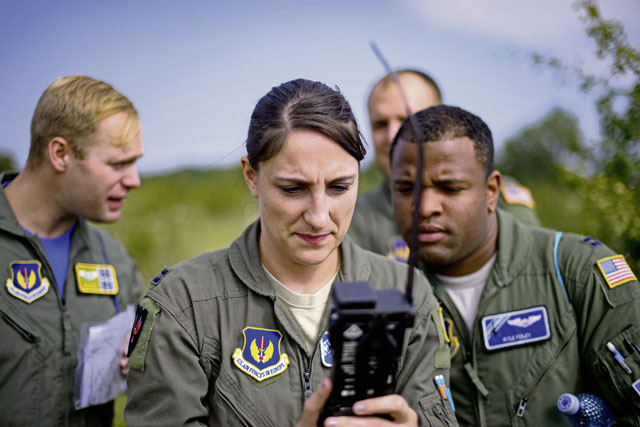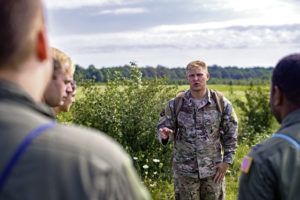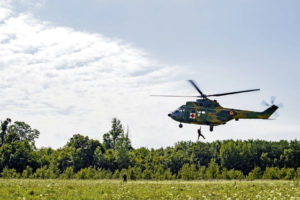
BOLOVANI, Romania — Downed pilots navigate through dense woods swatting away spiderwebs as they make their way to a safe location. With a compass and some training, they emerge from the timber to find themselves in an open field of tall yellow grass. The team works together to contact fellow Airmen piloting C-130Js in the area in hopes to be found from the sky.
Survival, Evasion, Rescue, and Escape specialists conducted training with 37th Airlift Squadron and Romanian air force pilots during Carpathian Summer 2018, a bilateral training exercise designed to enhance interoperability and readiness of forces by conducting combined air operations with the Romanian air force.
“Our purpose today is to work interoperable training with the Romanian rescue forces,” said Senior Master Sgt. Matthew Canoy, U.S. Air Forces in Europe Air Forces Africa SERE functional manager. “We put survivors on the ground, they communicate with their wingmen, and then they pass the information to the Romanians to get rescued.”

As the pilots rummage through their gear, they pull out a three-inch by five-inch mirror and a radio. As a face-painted pilot dials in a frequency to make communications, another takes the mirror and makes her way out to the field, the only spot within a two kilometer radius beaming with sunlight.
The sweat beads up on their faces as they listen to the SERE experts provide instructions.
“When they fly over us, you’re going to want to aim that mirror right at their cockpit,” said Canoy.
In the distance, the faint sound of propellers ripping away at the sky faded in and out.
“They’re getting close, but they keep flying away from us,” said one pilot to another.
The pilots then made contact with their wingmen overhead using the radio and gave them a heading.
Roaring engines echoed through the trees as the aircraft approached their location. The C-130J soared over them as they aimed the beam of light reflected off the mirror into their windows, hoping to be spotted. After a few passes, the pilots overhead confirmed visuals with the crew on the ground and gave them a set of coordinates to proceed to next.
After traversing another two-kilometer thicket, the pilots reached a rendezvous point where they called in Romanian helicopter pilots for their rescue.
“The helicopter doesn’t have a visual of their location,” said Staff Sgt. Christian Martin, 86th Operations Support Squadron SERE specialist. “They know roughly where they’re at and they’re doing a search pattern to identify where our isolated personnel are, but by using vectoring techniques, the aircrew are able to take the sound that they hear from the helicopter, use a heading to get them a visual of the helicopter, and then guide them in using left and right turns.”
Minutes pass and just above the treeline, a helicopter rises like the sun.
“We have a visual,” relayed the downed pilots to the Romanian helicopters. “Turn 90 degrees to your right.”

Each aircrew member took turns giving the helicopter pilots directions to their exact location. The choppers then landed, and the crew was “saved.”
U.S. Air Force Capt. Jane Marlow, 37th AS pilot, said the training was incredibly valuable.
“It provided an awesome refresher on survival and evasion, while allowing us to do some things like helicopter vectoring and fixed wing rescue that simply aren’t available at Ramstein,” she said.
Marlow spoke on the importance of the training and how it is essential for aircrew members.
“For those of us on the ground, the lessons learned in SERE may be the thing that saves your crew one day, should the worst ever happen,” said Marlow. “For the C-130Js in the exercise, it gave the crews the opportunity to train as on-scene commanders. The OSC role is absolutely vital to the rescue missions the 37th may be called upon to execute. The chance to run the scenario and train with an actual isolated person on the ground was awesome. The realism it brought to the search, coordination, and rescue portion of the training allowed the crews to really understand some of the challenges they would face in a true personnel recovery scenario.”
The multinational rescue operation improved cohesion between allied forces, according to Marlow, which is necessary due to the possibility of real-life situations as reflected in the training.
“Working search and rescue with the Romanians was an incredible opportunity,” she added. “It provided us the opportunity to simulate a realistic multinational rescue operation. In a true personnel recovery scenario, one of our allies may be the first to respond to a distress call. Sharing tactics, techniques, and procedures in exercises like this provides the opportunity to ensure we and our allies are primed to respond quickly and effectively when rescue is needed.”


